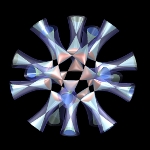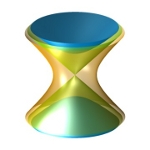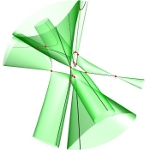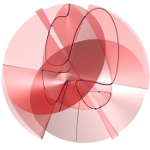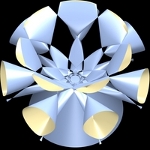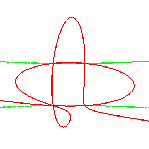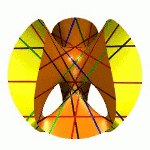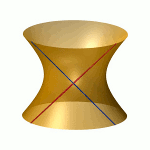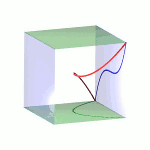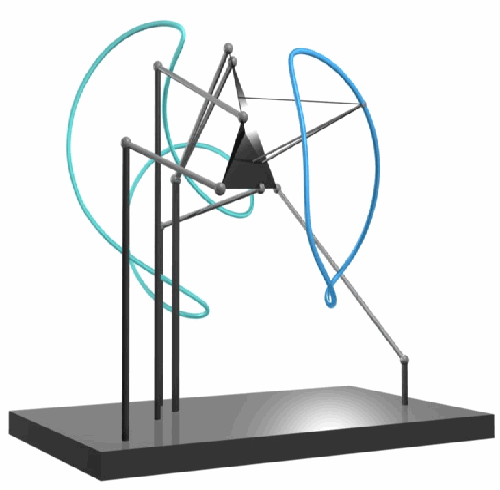Oberseminar Algebraische Geometrie (AG Lazić / AG Schreyer)
Notice for the Oberseminar Algebraische Geometrie (AG Lazić / AG Schreyer) of the winter term 2018/2019 : we meet regularly on Wednesdays in the building E2 4, room SR 10, starting at 2pm. The detailed schedule can be found in: https://www.math.uni-sb.de/ag/lazic/Oberseminar.html
Schedule of the summer term 2018
| Name | Title | Date |
| Zsolt Patakfalvi | Positivity of the Chow-Mumford line bundle for families of K-stable Q-Fano varieties | 26.04.2018 |
| Christian Lehn | Coisotropic subvarieties in holomorphic symplectic manifolds | 03.05.2018 |
| No seminar | Christi Himmelfahrt | 10.05.2018 |
| Stefan Schreieder | Stably irrational hypersurfaces of small slopes | 17.05.2018 |
| Christian Liedtke | A Néron-Ogg-Shafarevich criterion for K3 Surfaces | 24.05.2018 |
| No seminar | Fronleichnam | 31.05.2018 |
| Hanieh Keneshlou | The unirational component of moduli stacks of 6 gonal genus 11 curves | 21.06.2018 |
| Cinzia Casagrande | Fano 4-folds with rational fibrations | 28.06.2018 |
| Alessandra Sarti | Involutions of the Hilbert scheme of two points on a K3 surface |
05.07.2018 |
| Michael Hoff | K3 surfaces of small genus with many elliptic pencils | 12.07.2018 |
| Yeongrak Kim | An explicit matrix factorization of cubic hypersurfaces of small dimension | 02.08.2018 |
Zsolt Patakfalvi: The Chow-Mumford (CM) line bundle is a functorial line bundle on the base of any family of polarized varieties, in particular on the base of families of Q-Fano varieties (that is, Fano varieties with klt singularities). It is conjectured that it yields a polarization on the conjectured moduli space of K-semi-stable Q-Fano varieties. This boils down to showing semi-positivity/positivity statements about the CM-line bundle for families with K-semi-stable/K-polystable Q-Fano fibers. I present a joint work with Giulio Codogni where we prove the necessary semi-positivity statements in the K-semi-stable situation, and the necessary positivity statements in the uniform K-stable situation, including in both cases variants assuming K-stability only for very general fibers. Our statements work in the most general singular situation (klt singularities), and the proofs are algebraic, except the computation of the limit of a sequence of real numbers via the central limit theorem of probability theory. I also present a birational geometry application to the classification of Fano varieties.
Christian Lehn: The existence of coisotropic subvarieties in general projective irreducible symplectic varieties was conjectured by C. Voisin and is related to the structure of the Chow ring of such a variety and in particular to zero cycles. We present some methods to prove general existence results and apply them on special irreducible symplectic varieties. This is joint work with Gianluca Pacienza.
Stefan Schreieder: We show that a very general complex projective hypersurface of dimension N and degree at least log_2N+2 is not stably rational. The same statement holds over any uncountable field of characteristic p>>N.
Christian Liedtke: Given a family of smooth and projective manifolds over a pointed disk, one may ask whether this family has good reduction, that is, whether this family can be extended to a smooth family over the whole disk. A necessary condition for this is that the monodromy actions on cohomology, that is, the actions of the fundamental group of the pointed disk on the singular cohomology groups of a general fiber, is trivial. But does the converse hold? First, we generalise the setup as follows: let R be a complete local ring with field of fractions K and residue field k (Spec K generalises the pointed disk and Spec R generalises the whole disk), and let X be a smooth and projective variety over K. In this setup, good reduction translates into finding a smooth and proper scheme over Spec R with generic fiber X. Moreover, trivial monodromy translates into the action of the absolute Galois group of K on all l-adic cohomology groups H^*(\bar{X},Q_l) being unramified (or crystalline if l=char(k)).
For Abelian varieties, it is classical known by a theorem of Serre and Tate (and already established by Néron, Ogg, and Shafaravich for elliptic curves) that good reduction is equivalent to having unramified/crystalline Galois-actions on H^1.
In my talk, I will first introduce the above notions and then, I will talk on joint work with Matsumoto, Chiarellotto, and Lazda, where we study K3 surfaces over K and ask whether good reduction is equivalent to having unramfied/crystalline Galois-actions on H^2. It turns out that this is almost true, but that the right analog of a Néron-Ogg-Shafarevich criterion for K3 surfaces is rather subtle.
Hanieh Keneshlou: Considering a smooth d-gonal curve C of genus g, one may naturally ask about the existing possible number of pencils of degree d on C. Motivated by some questions of Micheal Kemeny, in this talk we will focus on this question for hexagonal curve of genus 11. Inside the moduli space of genus 11 curves, we describe a unirational irreducible component of the locus of curves possessing k mutually independent linear systems g^1_6 of type I, for the values k=5,...,10 .
Cinzia Casagrande: Smooth, complex Fano 4-folds are not classified, and we still lack a good understanding of their general properties. In the talk we will focus on Fano 4-folds with large second Betti number b2, studied via birational geometry and the detailed study of their contractions and rational contractions. We recall that a contraction is a morphism with connected fibers onto a normal projective variety, and a rational contraction is given by a sequence of flips followed by a (regular) contraction.
The main result that we want to present is the following: let X be a Fano 4-fold having a rational contraction X-->Y of fiber type (with dim Y > 0). Then either X is a product of surfaces, or b2(X) is at most 17, or Y is P1 or P2.
Alessandra Sarti: I will show how to use K3 surfaces with special geometry to construct involutions on their Hilbert scheme of two points. Indeed by using Torelli theorem one can show the existence of automorphisms of the Hilbert scheme, but it is a difficult problem to give an explicit realization. This is a joint work with S. Boissière, A. Cattaneo and D. Markushevich.
Michael Hoff: In my talk, I will discuss constructions of Brill-Noether general K3 surfaces of genus g=4,6 and 8 having many elliptic pencils of minimal degree (g+2)/2. Connections to unirationality of certain moduli spaces of lattice polarized K3 surfaces as well as Lazarsfeld-Mukai bundles are presented. This is a joint work in progress with Christian Bopp and Andreas Knutsen.
Yeongrak Kim: A pair of matrices (M,N) of a homogeneous polynomial f is called a matrix factorization of f when both of MN and NM coincides with f times the identity matrix. After introduced by Eisenbud in 1980, it plays a significant role in commutative algebra, algebraic geometry, and also in mathematical physics. A particularly interesting case is when M is linear. In the case, the cokernel of M becomes an Ulrich module, which is a maximal Cohen-Macaulay module having the maximal number of generators. It is natural to ask what is the Ulrich complexity uc(f), which is the smallest rank of Ulrich modules on S_f. Recently, Manivel showed that uc(f) is at most 9 when f is a general cubic form defined in at most 9 variables using the invariant theory on the Lie group E_6. In this talk, I will give another proof of the construction of a rank 9 Ulrich module using Shamash's construction. In particular, I will describe an explicit matrix factorization. Two methods are indeed overlapping; by recovering the Cartan cubic form which is E_6-invariant. Here, the Cartan cubic form admits a matrix factorization induced by its Hessian. I also give a complete classification of cubic forms with this property. This is a joint work in a progress with F.-O. Schreyer.
Schedule of the winter term 2017/18
|
Name |
Title | Date |
| Pagona Koulakidou | Divisors as fibres of morphisms | 19.10.17 |
| Nikolaos Tsakanikas | On varieties birational to abelian varieties | |
| George H. Hitching | Tangent cones to generalised theta divisors and generic injectivity of the theta map | 07.12.17 |
| Gianluca Pacienza | Density of Noether-Lefschetz loci of irreducible holomorphic symplectic varieties and applications | 18.01.18 |
| Andrea Fanelli | Del Pezzo fibrations in positive characteristic | 25.01.18 |
| Luca Tasin | A non-vanishing result for weighted complete intersections | 01.02.18 |
Luca Tasin: Let X be a smooth (or mildly singular) projective variety and let H be an ample line bundle on X. Kawamata conjectured that if H-K_X is ample, then the linear system |H| is not empty. I will explain that the conjecture holds true for weighted complete intersections which are Fano or Calabi-Yau, relating it with the Frobenius coin problem. This is based on a joint work with M. Pizzato and T. Sano.
Andrea Fanelli: In this talk, I will discuss some pathologies for the generic fibre of del Pezzo fibrations in characteristic p>0, motivated by the recent developments of the MMP in positive characteristic. The main application of the joint work with Stefan Schröer concerns 3-dimensional Mori fibre spaces.
Gianluca Pacienza: We will try to illustrate how useful such density results can be by presenting several (old and new) applications to: the existence of rational curves on projective IHS varieties, the study of relevant cones of divisors, the study of lagrangian fibrations and a refinement of Hassett's result on cubic fourfolds whose Fano variety of lines is isomorphic to to an Hilbert scheme of 2 points on a K3 surface. We also discuss Voisin's conjecture on the existence of coisotropic subvarieties on IHS varieties and relate it to a stronger statement on Noether-Lefschetz loci in their moduli spaces.
George H. Hitching: Let C be a Petri general curve of genus g. The tangent cones of the Riemann theta divisor on Pic^{g-1}(C) have been used in various ways by Kempf and Schreyer and by Ciliberto and Sernesi to give new proofs of Torelli's theorem. We use a related approach to study the generalised theta divisor D(V) of a semistable bundle V over C of rank r and integral slope. For large enough g, we show how a sufficiently general such V can be reconstructed from the tangent cone of D(V) at a suitable singular point. We use this to give a constructive proof and a sharpening of Brivio and Verra's theorem that the theta map from the moduli space of semistable bundles of rank r and trivial determinant to the projective space |r\Theta| is generically injective for large values of g. (Joint work with Michael Hoff)
Schedule of the summer term 2017
| Name | Title |
Date |
| Christian Bopp | Moduli of lattice polarized K3 surfaces via relative canonical resolutions | 18.05. |
| Sascha Blug | Die Picard Gruppe von hyperelliptischen Kurven | 01.06. |
| Jonas Baltes | Der Riemannsche Abbildungssatz und Metriken konstanter Krümmung auf Riemannschen Flächen | |
| Janik Schug | Puiseux-Reihen | 08.06. |
| Christian Ikenmeyer | Formula size, iterated matrix multiplication, and algebraic geometry | |
| Andreas L. Knutsen | Brill-Noether theory of curves on abelian surfaces | 29.06. |
| Thomas Peternell | Descent of numerically flat vector bundles and singular ball quotients | |
| Hanieh Keneshlou |
On Accola's genus bound for algebraic curves |
06.07. |
| Frank-Olaf Schreyer | Horrocks splitting on products of projective spaces | |
| Michael Kemeny | The Prym-Green conjecture for curves of odd genus | 03.08. |
| Yeongrak Kim | Ulrich bundles on the intersection of two 4-dimensional quadrics | 09.08. |
| Jonas Baltes | Der Riemannsche Abbildungssatz und Metriken konstanter Krümmung auf Riemannschen Flächen (Teil II) | 24.08. |
| Janik Schug | Puiseuxreihen und ihre Anwendungen | 05.10. |
Yeongrak Kim: A coherent sheaf F on a projective variety X is Ulrich if its pushforward by a finite degree map is trivial. Since they naturally appears in several different theories, the study of Ulrich bundles becomes important. In this talk, I will discuss two different approaches to construct Ulrich bundles on the intersection of two 4-dimensional quadrics: via Serre correspondence and via derived categories. I will also briefly explain a connection between generalized theta series. This is a joint work with Y. Cho and K.-S.Lee.
Michael Kemeny: We will present a proof of the Prym-Green conjecture on the resolution of a paracanonical curve of odd genus and arbitrary torsion level. The proof proceeds by using curves on ruled surfaces over an elliptic curve. These surfaces naturally arise as desingularizations of limiting K3 surfaces with elliptic singularities, and come up in Arbarello-Bruno-Sernesi's study of the Wahl map and deformations of the cone. They have the downside of being irregular, which makes the study of syzygies more complicated than for K3s, but on the upside they allow for inductive arguments on the genus of the curve, which is not possible for a K3. Joint with Gabi Farkas.
Andreas L. Knutsen: The Brill-Noether theory of curves on K3 surfaces is well understood. Until recently, quite little has been known for curves on abelian
surfaces. In the talk I will present some recent results obtained with M. Lelli-Chiesa and G. Mongardi.
In particular, we show that the general curve in the linear system |L| on a general primitively polarized abelian surface (S,L) is Brill-Noether
general, as in the K3 case. However, contrary to the K3 case, there are smooth curves in |L| possessing "unexpected" linear series, that is, with negative Brill-Noether number. As an application, we obtain the existence of components of special Brill-Noether loci of the expected dimension in the moduli space of curves.
Thomas Peternell: In my talk I will explain recent results with Greb, Kebekus and Taji concerning the uniformization of klt spaces whose (orbifold) Chern classes are extremal in the sense that they satisfy the Miyaoka-Yau equality.
